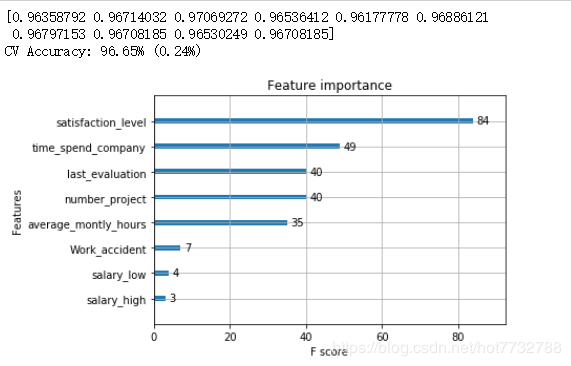您好,登录后才能下订单哦!
密码登录
登录注册
点击 登录注册 即表示同意《亿速云用户服务条款》
小编给大家分享一下python中xgboost怎么用,相信大部分人都还不怎么了解,因此分享这篇文章给大家参考一下,希望大家阅读完这篇文章后大有收获,下面让我们一起去了解一下吧!
1.数据读取
利用原生xgboost库读取libsvm数据
import xgboost as xgb data = xgb.DMatrix(libsvm文件)
使用sklearn读取libsvm数据
from sklearn.datasets import load_svmlight_file X_train,y_train = load_svmlight_file(libsvm文件)
使用pandas读取完数据后在转化为标准形式
2.模型训练过程
1.未调参基线模型
使用xgboost原生库进行训练
import xgboost as xgb
from sklearn.metrics import accuracy_score
dtrain = xgb.DMatrix(f_train, label = l_train)
dtest = xgb.DMatrix(f_test, label = l_test)
param = {'max_depth':2, 'eta':1, 'silent':0, 'objective':'binary:logistic' }
num_round = 2
bst = xgb.train(param, dtrain, num_round)
train_preds = bst.predict(dtrain)
train_predictions = [round(value) for value in train_preds] #进行四舍五入的操作--变成0.1(算是设定阈值的符号函数)
train_accuracy = accuracy_score(l_train, train_predictions) #使用sklearn进行比较正确率
print ("Train Accuary: %.2f%%" % (train_accuracy * 100.0))
from xgboost import plot_importance #显示特征重要性
plot_importance(bst)#打印重要程度结果。
pyplot.show()使用XGBClassifier进行训练
# 未设定早停止, 未进行矩阵变换
from xgboost import XGBClassifier
from sklearn.datasets import load_svmlight_file #用于直接读取svmlight文件形式, 否则就需要使用xgboost.DMatrix(文件名)来读取这种格式的文件
from sklearn.metrics import accuracy_score
from matplotlib import pyplot
num_round = 100
bst1 =XGBClassifier(max_depth=2, learning_rate=1, n_estimators=num_round, #弱分类树太少的话取不到更多的特征重要性
silent=True, objective='binary:logistic')
bst1.fit(f_train, l_train)
train_preds = bst1.predict(f_train)
train_accuracy = accuracy_score(l_train, train_preds)
print ("Train Accuary: %.2f%%" % (train_accuracy * 100.0))
preds = bst1.predict(f_test)
test_accuracy = accuracy_score(l_test, preds)
print("Test Accuracy: %.2f%%" % (test_accuracy * 100.0))
from xgboost import plot_importance #显示特征重要性
plot_importance(bst1)#打印重要程度结果。
pyplot.show()2.两种交叉验证方式
使用cross_val_score进行交叉验证
#利用model_selection进行交叉训练
from xgboost import XGBClassifier
from sklearn.model_selection import StratifiedKFold
from sklearn.model_selection import cross_val_score
from sklearn.metrics import accuracy_score
from matplotlib import pyplot
param = {'max_depth':2, 'eta':1, 'silent':0, 'objective':'binary:logistic' }
num_round = 100
bst2 =XGBClassifier(max_depth=2, learning_rate=0.1,n_estimators=num_round, silent=True, objective='binary:logistic')
bst2.fit(f_train, l_train)
kfold = StratifiedKFold(n_splits=10, random_state=7)
results = cross_val_score(bst2, f_train, l_train, cv=kfold)#对数据进行十折交叉验证--9份训练,一份测试
print(results)
print("CV Accuracy: %.2f%% (%.2f%%)" % (results.mean()*100, results.std()*100))
from xgboost import plot_importance #显示特征重要性
plot_importance(bst2)#打印重要程度结果。
pyplot.show()
使用GridSearchCV进行网格搜索
#使用sklearn中提供的网格搜索进行测试--找出最好参数,并作为默认训练参数
from xgboost import XGBClassifier
from sklearn.model_selection import GridSearchCV
from sklearn.metrics import accuracy_score
from matplotlib import pyplot
params = {'max_depth':2, 'eta':0.1, 'silent':0, 'objective':'binary:logistic' }
bst =XGBClassifier(max_depth=2, learning_rate=0.1, silent=True, objective='binary:logistic')
param_test = {
'n_estimators': range(1, 51, 1)
}
clf = GridSearchCV(estimator = bst, param_grid = param_test, scoring='accuracy', cv=5)# 5折交叉验证
clf.fit(f_train, l_train) #默认使用最优的参数
preds = clf.predict(f_test)
test_accuracy = accuracy_score(l_test, preds)
print("Test Accuracy of gridsearchcv: %.2f%%" % (test_accuracy * 100.0))
clf.cv_results_, clf.best_params_, clf.best_score_3.早停止调参–early_stopping_rounds(查看的是损失是否变化)
#进行提早停止的单独实例
import xgboost as xgb
from xgboost import XGBClassifier
from sklearn.metrics import accuracy_score
from matplotlib import pyplot
param = {'max_depth':2, 'eta':1, 'silent':0, 'objective':'binary:logistic' }
num_round = 100
bst =XGBClassifier(max_depth=2, learning_rate=0.1, n_estimators=num_round, silent=True, objective='binary:logistic')
eval_set =[(f_test, l_test)]
bst.fit(f_train, l_train, early_stopping_rounds=10, eval_metric="error",eval_set=eval_set, verbose=True) #early_stopping_rounds--当多少次的效果差不多时停止 eval_set--用于显示损失率的数据 verbose--显示错误率的变化过程
# make prediction
preds = bst.predict(f_test)
test_accuracy = accuracy_score(l_test, preds)
print("Test Accuracy: %.2f%%" % (test_accuracy * 100.0))4.多数据观察训练损失
#多参数顺
import xgboost as xgb
from xgboost import XGBClassifier
from sklearn.metrics import accuracy_score
from matplotlib import pyplot
num_round = 100
bst =XGBClassifier(max_depth=2, learning_rate=0.1, n_estimators=num_round, silent=True, objective='binary:logistic')
eval_set = [(f_train, l_train), (f_test, l_test)]
bst.fit(f_train, l_train, eval_metric=["error", "logloss"], eval_set=eval_set, verbose=True)
# make prediction
preds = bst.predict(f_test)
test_accuracy = accuracy_score(l_test, preds)
print("Test Accuracy: %.2f%%" % (test_accuracy * 100.0))
5.模型保存与读取
#模型保存
bst.save_model('demo.model')
#模型读取与预测
modelfile = 'demo.model'
# 1
bst = xgb.Booster({'nthread':8}, model_file = modelfile)
# 2
f_test1 = xgb.DMatrix(f_test) #尽量使用xgboost的自己的数据矩阵
ypred1 = bst.predict(f_test1)
train_predictions = [round(value) for value in ypred1]
test_accuracy1 = accuracy_score(l_test, train_predictions)
print("Test Accuracy: %.2f%%" % (test_accuracy1 * 100.0))以上是“python中xgboost怎么用”这篇文章的所有内容,感谢各位的阅读!相信大家都有了一定的了解,希望分享的内容对大家有所帮助,如果还想学习更多知识,欢迎关注亿速云行业资讯频道!
免责声明:本站发布的内容(图片、视频和文字)以原创、转载和分享为主,文章观点不代表本网站立场,如果涉及侵权请联系站长邮箱:is@yisu.com进行举报,并提供相关证据,一经查实,将立刻删除涉嫌侵权内容。